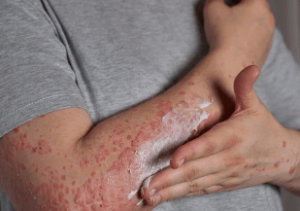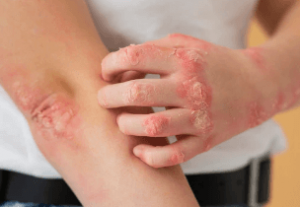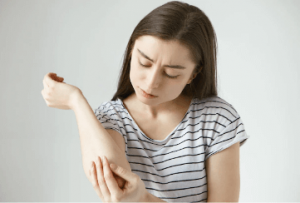Psoriasis : Definition/ Types
 Psoriasis affects about %27 of the world population, and it is also a chronic skin disease. It is a highly common disease in the community, and usually have a chronical course. As many chronic diseases, it exhibits an attribute for periodically recurrence. Incidence of reoccurred cases vary across individuals. Occasionally, psoriasis patients may live restfully for many years, without any complaints and symptoms of disease. Typical symptoms of psoriasis, which are the source for terming the disease, are silvery-white, thick, bright and dry scaly flaking located on a raised areas of rosy skin.
Psoriasis affects about %27 of the world population, and it is also a chronic skin disease. It is a highly common disease in the community, and usually have a chronical course. As many chronic diseases, it exhibits an attribute for periodically recurrence. Incidence of reoccurred cases vary across individuals. Occasionally, psoriasis patients may live restfully for many years, without any complaints and symptoms of disease. Typical symptoms of psoriasis, which are the source for terming the disease, are silvery-white, thick, bright and dry scaly flaking located on a raised areas of rosy skin.
Psoriasis can involve all areas covered by skin tissue. It can affect the scalp, nails, hand, foot, trunk, knee, elbow, briefly; the whole body from head to toe. Severity of the involvement can vary from person to person. Moreover, while disease can be clinically appear as a single patch or multiple plaques across some patients, it can also affect large areas of skin by spreading to various areas of the body. Affected areas are mostly the knee, elbow, dorsum, scalp and genital area.
The characteristic clinical manifestation is white, thin plaques located on a red, well-shaped base; but psoriasis can also exhibit single red areas without plaques or inflamed, pinhead-sized pustules formed on those non-plaque, red bases. When the diagnosis made by only clinical observations, psoriasis can occacinally be confused with other allergic skin disorders such as; eczema.
What are the types of psoriasis?
Plaque psoriasis (psoriasis):
It is the most common type, and characterized by red, scaly plaques on the knee and elbow.
Inverse psoriasis:
Usually, it occurs on skinfolds such as; axilla, inguinal area, inframammary line. The differential diagnosis of psoriasis should be done in certain areas, considering the eczema. Once psoriasis affects axilla, inguinal area, tow-web, anal area and inframammary line; red, humid plaque formation will appear rather than the classical white-silver, scaly patches.
Guttate (eruptive) psoriasis:
This clinical form, which is common across particularly in children, presents by numerous droplet-like or coin-seized lesions.
Palmoplantar (palm, sole) psoriasis:
Psoriasis, which involve palm and sole, have two different types: Beforely, formation of lesions appear as red, scaly plaques, or secondly, formation of lesions appear as acne-like pustules on a red base. This clinical manifestation is called pustular psoriasis. Pustular psoriasis is highly persistent and can progress for many years.
Scalp psoriasis:
The involvement of scalp in psoriasis is quite common. It can affect only a small area on scalp or whole scalp, like skin involvement, and may cause excessive flaking like dandruff. Furthermore, hair follicles are not attached with each other. So, if they are pulled out, you can see that it is not a fatty crust. Although, psoriasis does not cause hair loss, it causes itching, fragile skin to bleeding and scalp dryness on affected areas.
Psoriatic nails, nail psoriasis:
Nail involvement may also occur in some patients. This clinical manifestation occurs in 10-78% of psoriasis patients. Nail psoriasis can accompany to other psoriatic lesions in the body, as it can be limited to just nails. If psoriasis affects nails alone and there is not any skin lesion, it is difficult to be diagnosed. Rate of fingernail involvement is 50% and toenail involvement is 35% in psoriasis. Pinhead-sized pits and thickening on nail, thick scaling under nail, separation of nail from the fold, yellow or brown discoloration on nail may occur. Among the trigger factors that intensify nail psoriasis are considered as; long nails, false nails, plucking the cuticle, removing the debris under the nail, irritants and fungal infections. Psoriatic nail is a compelling and refractory condition for both physicians and patients. Before initiating therapy, differential diagnosis of nail psoriasis from nail fungus should be performed.
Erythrodermic psoriasis:
It is a common and severe form of psoriasis which involves more than 80% of body surface. All symptoms of psoriasis can be observed, but the most significant symptom is redness. Patients can experience some complications such as; fever, fatigue, malaise, fluid and electrolyte loss. So, they need to be treated in hospital service.
Pustular psoriasis:
This clinical form can be seen during a classical psoriasis manifestation, which has already developed long ago, and it can also be seen as the first, initial symptom as well. It can be localized or generalized. The localized form is characterized by yellow pustules on a red ground symmetrically on the palms and soles. Pustular psoriasis can affect palm and sole without any symptom on other areas of the body. In generalized form, occurring with fever, 2-3 mm pustules spread throughout the body, including palm and sole. Occasionally, severe fever and fatigue can be occur in pustular psoriasis. General condition of the patient is not good and clinical manifestation is severe. Severe complications such as; electrolyte imbalance and low calcium levels can occur. Swelling on the ankles can be seen. These systemic symptoms manifest a parallel development with skin symptoms. Systemic symptoms regress during scaling period, or it can also be disappeared even. Mucosa is rarely affected by psoriasis pustules.
Joint psoriasis (psoriatic arthritis)
Joint involvement may be experienced additionally by at least 5-8% of patients during all types of psoriasis. It is a seronegative arthritis, and usually occurs following skin involvement. If skin involvement is severe, psoriatic arthritis can occur more frequently. Some patients have pains on a few, small joints, and some patient complaint about swelling which progressively and slowly affects all joints. Terminal joints of hand and foot, joint of knee and ankle are the most common affected areas. Typical deformities in the fingers can occur as a result of recurrent inflammation of the joints (arthritis) seizures.
Treatment
 The diagnosis of psoriasis is usually made by dermatological examination. If it is clinically confused with other conditions, a piece of sample from skin may be necessary for pathological examination. There is no special blood test to confirm diagnosis of psoriasis.
The diagnosis of psoriasis is usually made by dermatological examination. If it is clinically confused with other conditions, a piece of sample from skin may be necessary for pathological examination. There is no special blood test to confirm diagnosis of psoriasis.Who gets psoriasis?
Psoriasis occurs in both genders. However, disease incidence have more frequency in women rather than men. The disease can arise at any age. Age of onset is below 10 years in 10-15% of patients. Mean age of onset is 28.Are all types of psoriasis similar?
Psoriasis can appear in many different clinical forms. In the most common type of the disease, typical symptoms are raised, red, scaly patches on the skin which covered by thick plaque with white silvery flaking like dandruff, especially on the regions such as; knee, elbow and scalp. Occasionally, the patches can be widespread enough to cover the entire body.Involvement of scalp occurs in nearly 50% of patients. In some cases, only scalp involvement can occur.
Disease in children may exhibit different characteristics. Usually, symptoms are red, scalypatches with 1-10 mm in diameter. These symptoms may increase especially after upper respiratory tract infections.
The disease can be limited to skinfolds such as; axilla, groin, substernal areas in certain patients. Since those areas involved in psoriasis have a humid characteristic, disease presents with only red patches without flaking like dandruff.
Psoriasis can also cause swelling in the form of acne, as well as flaking and redness. Furthermore, as skin rashes are limited to the regions of palm and sole (palmoplantar pustular psoriasis), they may be also widespread enough to cover whole body.
Psoriasis can cause the pitting, thickening, separation, the point of bleeding and changes of yellowing on the nails. These symptoms may be associated with other skin rashes as well as occuring alone.
Joint involvement can be detected in 10% of patients with psoriasis. Especially, involvements of hand and foot are common. Large joints are rarely affected. Diagnosis of the psoriasis accompanied by other rashes can be made easily, but the diagnosis of the psoriasis with single joint involvement be rather difficult.
In the event that psoriasis cause an appearance of widespread rashes and flaking like dandruff, it may also lead to several complaints such as fever, hypothermia, chills and fatigue.
What should psoriasis patients pay attention to?
- Should not use any unnecessary medication.
- Should eat healthily.
- Should avoid from alcohol and smoking.
- Should maintain the ideal body weight.
- Should be treated immediately in the event of infection occurrence such as; tooth decay or sinusitis.
- Should exercise regularly.
- Should learn stress management to cope with stress.
- Should avoid excessive sun
- Should be a person who is at peace with the world and life.
What is the role of the immune system in psoriasis?
Immune system is composed of defence cells to protect body against diseases. By functional disruption of those cells, certain diseases occur. In psoriasis, abnormal function of the immune cells leads to a stimulation and rapid proliferation process in the skin cells.Yet, it is not clear that causes of the abnormal function of immune system and the stimulation for skin cells, certain triggering factors are already known to have a role in that process.
Severity
 As one of the most severe skin diseases, psoriasis makes patients nervous because of its dermatological appearance and the concern about it may be contagious. Psoriasis can underpin for several diseases such as; cardiovascular diseases and obesity, in the event that it is neglected and not restrained.
As one of the most severe skin diseases, psoriasis makes patients nervous because of its dermatological appearance and the concern about it may be contagious. Psoriasis can underpin for several diseases such as; cardiovascular diseases and obesity, in the event that it is neglected and not restrained.
It is more common among patients with a family history of psoriasis. It is a chronic disease that can affect 1-3% of the population. Psoriasis shows up with white patches like a pearl which are settled on a red, well-demarcated base. It is called as “Psoriasis” due to colour of patches. The diagnosis is made by dermatological examination. However, in some cases, biopsy specimens are required. Usually, it can occur on scalp, knee, elbow and nail, but it can also be widespread throughout the body. Immune system and genetic factors are predominant in the disease ethology. The risk of psoriasis development for a person without psoriatic family history is 1-2%, while it is increased up to 50% of rates for a person with one or more psoriatic parent.
The rumour of ”Psoriasis patients can not marry” is a completely false whisper. Disease consists of recovery and recurrence periods. Therefore, it is a disease that can persist for life. Women usually develops psoriasis at early ages. Age of onset is usually 20s and 30s. While there is not a certain base, we can say that course of disease is more resistant with a family history of the disease and depending on how early occurred. Psoriasis can affect the quality of life, especially when it is highly widespread on the body. People should not rely on negative groundless rumours such as; “psoriasis is contagious, psoriasis patients can not marry”. Since psoriasis is not contagious, it is not a life threatening condition for other people.
It may be a sign of any other diseases. Physical trauma, cold weather, bacterial and viral infections, stress, discontinuation of primarily analgesics and certain blood pressure medications or cortisone, alcohol and smoking are triggers for psoriasis. Psoriasis may underpin for several different diseases such as; articular rheumatism (arthritis), hypertension, high cholesterol, obesity, depression, diabetes and coronary heart disease.
Symptoms
 The most common form is plaque-like psoriasis on the skin and characterized by redness, flaking and desquamation especially on the knee, elbow, dorsum and coccyx called as the sacrum. Psoriasis may exhibit different manifestations in children, adults and elders. While the only red flaking is the psoriatic symptoms in children, adult population experience all symptoms of the disease.
The most common form is plaque-like psoriasis on the skin and characterized by redness, flaking and desquamation especially on the knee, elbow, dorsum and coccyx called as the sacrum. Psoriasis may exhibit different manifestations in children, adults and elders. While the only red flaking is the psoriatic symptoms in children, adult population experience all symptoms of the disease.
Skin symptoms are characterized by well-shaped, rosy patches covered with silvery plaque on the surface. This lesion is a dry formation, and characterized by areas of pint point bleeding when it is scraped. When you rub the skin with your hand, lesions will peel like dust. Small nail pitting can also appear, and the nail will be separated from nail fold. Thickened or broken nails can show up. Lesions can also occur in the inguinal region, axilla (armpit) and genital area.
Causes of Psoriasis
Though cause of psoriasis is not fully understood, it is considered that disease can occur as a result of an abnormality in the white blood cells. In researches, it is determined that immune system is stimulated by several causes (stress, medication, infection), and this process accelerates the growth of skin cells. Maturation of normal skin cells takes time nearly 28-30 days, but this period can drop to 3-4 days in psoriasis patients. Thus, proliferating cells accumulates on the surface and yields to a thick plaque.
During the disease process, following an inflammation, adesquamation phase occurs. Changes in skin metabolism ¬is a result of disease rather than being a cause. Risk for psoriasis development is increased in some conditions such as; injury, trauma, rheumatic fever, certain diseases with a microorganism ethology. In addition, cancer and immunosuppressant medications, used for the conditions such as; organ transplantation, yield also to an increased risk of psoriasis.
Psychological factors such as stress, tension, lack of love and the mother – child relationship disorders may ensure development or exacerbation of psoriasis. Additionally, hypocalcaemia and hormonal effects are considered to be influential for development of psoriasis.
Role of immune system
 Immune system is composed of defence cells to protect body against diseases. By functional disruption of those cells, certain diseases occur. In psoriasis, abnormal function of the to immune cells leads to a stimulation and rapid proliferation process in the skin cells.
Immune system is composed of defence cells to protect body against diseases. By functional disruption of those cells, certain diseases occur. In psoriasis, abnormal function of the to immune cells leads to a stimulation and rapid proliferation process in the skin cells.
Yet, it is not clear that causes of the abnormal function of immune system and the stimulation for skin cells, certain triggering factors are already known to have a role in that process.
Misc. questions
 Psychological stress and distress may trigger the psoriasis among certain people who have a tendency, or may lead to an increase of the current rashes. Therefore, psychological help will provide an effect by reducing the severity of the disease on people who have higher stress levels. Also, dental caries, tonsillitis, infectious diseases such as urinary tract infections and damages of rubbing, hitting, scratching, high alcohol consumption, certain metabolic disorders (hypocalcaemia), and medications may trigger the psoriasis.
Psychological stress and distress may trigger the psoriasis among certain people who have a tendency, or may lead to an increase of the current rashes. Therefore, psychological help will provide an effect by reducing the severity of the disease on people who have higher stress levels. Also, dental caries, tonsillitis, infectious diseases such as urinary tract infections and damages of rubbing, hitting, scratching, high alcohol consumption, certain metabolic disorders (hypocalcaemia), and medications may trigger the psoriasis.Psychological Stress
In studies, it is found that psoriasis shows an alteration, especially depending on severe lifestyle changes. In some recent studies, it is determined that there is an increase in blood levels of certain substances which have a trigger effect on immune system, along with the stress.Bacterial and viral infections
It is a fact that psoriasis may be intensifiedin children, due to colonization of oropharyngeal bacteria called as ”streptococcus”. Therefore, patients, who have frequently tonsillitis, need to receive a complete treatment. Even if the patient has no compliant, dermatologists usually order an antibiogram test through collecting sample with the aid of a cotton swab to acquire a throat culture. Apart from these conditions, diseases where there is a constant reservoir of infection in the body (e.g. dental caries) requires an essential treatment.Climate
The severity of psoriasis decreases in sunny weathers and intensifies particularly in the winter. Also, incidence of psoriasis has a less frequency in the areas with low altitude. Since moisture content is less in dry climates, patients experience more itching on skin patches. So, psoriasis patients may be more relieved in areas with humid climate. In addition, warm air heaters cause a composition of dry air, and itching on the skin patches will be intensified. Psoriasis patients should use plenty of moisturizer in winters.Koebner phenomenon
Injury of non-psoriatic skin may lead to new psoriasis lesions in the region. This condition is called as Koebner phenomenon. Sunburn and skin cuts may lead to that condition. However, the sun may be beneficial for psoriasis, it should be avoided from sunlight as much intense as to cause a sunburn. Psoriasis patients should definitely avoid from administration of permanent tattoo, since psoriasis may also develop in tattooed areas. Intense itching along with the effect of Koebner phenomenon of surrounding skin, may lead to a new formation of psoriasis lesions, therefore it should be treated. Many psoriasis patients alsoremove their skin patches by pulling out. That habit may also lead to the same issue.Who gets psoriasis?
Psoriasis occurs in both genders. However, disease incidence have more frequency in women rather than men. The disease can arise at any age. Age of onset is below 10 years in 10-15% of patients. Mean age of onset is 28 years old.How is psoriasis diagnosed?
The diagnosis of psoriasis is usually made by dermatological examination. If it is clinically confused with other conditions, a piece of sample from skin may be necessary for pathological examination. There is no special blood test to confirm diagnosis of psoriasis.Are all types of psoriasis similar?
Psoriasis can appear in many different clinical forms. In the most common type of the disease, typical symptoms are raised, red, scaly patches on the skin which covered by thick plaque with white silvery flaking like dandruff. It occurs especially on the regions such as; knee, elbow and scalp. Occasionally, the patches can be widespread enough to cover the entire body.Scalp involvement occurs in nearly 50% of patients. In some cases, only scalp involvement can occur.Disease in children may exhibit different characteristics. Usually, symptoms are red, scaly patches with 1-10 mm in diameter. These symptoms may increase especially after upper respiratory tract infections.The disease can be limited to skinfolds such as; axilla (armpit), groin, substernal (below chest) areas in certain patients. Since those areas involved in psoriasis have a humid skin characteristic, disease presents with only red patches without flaking like dandruff.Psoriasis can also cause swelling in the form of acne, as well as flaking and redness. Furthermore, as skin rashes are limited to the regions of palm and sole (palmoplantar pustular psoriasis), they may be also widespread enough to cover whole body.Psoriasis can cause the pitting, thickening, separation, the point of bleeding and changes of yellowing on the nails. These symptoms may be associated with other skin rashes as well as occurring alone.Joint involvement can be detected in 10% of patients with psoriasis. Especially, involvements of hand and foot are common. Large joints are rarely affected. Diagnosis of the psoriasis accompanied by other rashes can be made easily, but the diagnosis of psoriasis with single joint involvement be rather difficult.In the event that psoriasis cause an appearance of widespread rashes and flaking like dandruff, it may also lead to several complaints such as fever, hypothermia, chills and fatigue.Is there a special diet for psoriasis?
There are no special diet for the disease. In recent studies, it is reported that fish oil containing omega-3 may improve the disease, presence of the disease is more common in patients who consume saturated fats and excessive weight gain can exacerbate the complaints related to skinfold areas.Does psoriasis cause hair loss?
Psoriasis does not normally cause hair loss. However, hair loss can occur while patients try to remove extra thick scalp plaques, surrounding the hair. In addition, some drugs used to treat the disease can cause temporary hair loss.Where does psoriasis show up?
Psoriasis affect the scalp, knees, elbows and trunk most commonly. However, it can show up on anywhere – including the nails, palms, soles, genital areas and face. Lesions are usually symmetrical, namely occur at the same places on the right and left sides of the body.What should psoriasis patients pay attention to?
- Should not use any unnecessary medication
- Should eat healthily
- Should avoid from alcohol and smoking
- Should maintain the ideal body weight
- Should be treated immediately in the event of infection occurrence such as; tooth decay or sinusitis
- Should exercise regularly
- Should learn stress management to cope with stress
- Should avoid excessive sun
- Should be a person who is at peace with the world and life
What is the role of the immune system in psoriasis?
Immune system is composed of defence cells to protect body against diseases. By functional disruption of those cells, certain diseases occur. In psoriasis, abnormal function of the to immune cells leads to a stimulation and rapid proliferation process in the skin cells. Yet, it is not clear that causes of the abnormal function of immune system and the stimulation for skin cells, certain triggering factors are already known to have a role in that process.Contagious?
 Psoriasis is a chronic skin disease which gives symptoms as redness at where the disease settled and emerges at intervals. Upper layer of the skin gets thicken and grown, then white-silver patches appear. Skin begins to regeneration in every few days. Thickness of the layer of dead cells on the skin is increased.
Psoriasis is a chronic skin disease which gives symptoms as redness at where the disease settled and emerges at intervals. Upper layer of the skin gets thicken and grown, then white-silver patches appear. Skin begins to regeneration in every few days. Thickness of the layer of dead cells on the skin is increased.
Although there may be several symptoms on multiple areas of the body, symptoms are predominantly seen on elbow, knee, scalp, lumbar area and nails. Course of disease can be moderate in some patients, while it can be severe in other patients.
Psoriatic redness and crusting may occur on multiple areas of the body. Lesions are a kind of problem which are curable. Incidence of psoriasis is 2% in average. This figure demonstrates how much the disease is common. Psoriasis is more like to occur among early ages.
Presence of psoriasis among the family increase the predisposition to psoriasis in other family members. In addition, psoriasis is a contagious disease, since it is not caused by microorganisms.